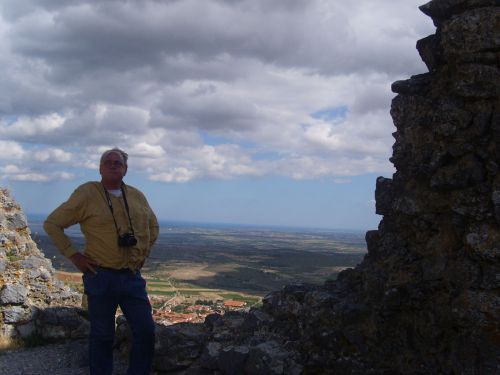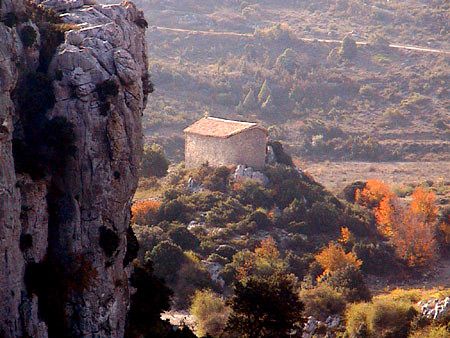Opoul-Perillos
You can find the commune of Opoul-Perillos, which is huge, 5053 hectares, in the area called Corbières-Martimes, by taking the D6009 south from Narbonne to Les Cabanes de Fitou, then turning right of the D9 for Opoul-Perillos.
As you approach the village, you will see the castle of Hautpoul on the horizon, high on it's plateau 400 metres high.

It is immense and called Hautpoul – Opoul or Haut Poul or "high pool." This is only a small part of the commune, for "Opoul" was once separate from Perillos, an abandoned village to the north. The whole area is limestone territory, with caves and cracks and white rocks, between them red clay, all scattered with small vineyards. The region has been inhabited for thousand of years; the village of Tautavel, with its museum about prehistoric man who lived there 35,000 years ago, is 17 km south-west from Opoul-Perillos.
I particularly wanted to visit the château, which is beside the old Roman mining route across the Corbières. It was built in 1246 by James I of Aragon, (Pyrenees-Orientales were part of his territory then) but the sweet water wells in it, so important to the Romans, were known long before then. Before you climb up to it, note the warning sign about the "citernes ouvertes." 

An old well in the castle - and a medieval toilet!
While the castle is called Hautpoul, the plateau on which it stands is called Terre Salvayre which means, Land of the Saviour, or Salveterra in Occitan. Excavations have been done in the castle, Roman traces have been found but no sign of any buildings. However, local historians all agree the Romans occupied this plateau. At the foot of it have been found traces of a village, known as Salvaterrat.
During various wars over defending the France/Spain border, the chateau was occupied alternatively by the Spanish and the French. In the reign of Louis XIV the border was pushed back to its current position beyond Perpignan and the castle became French in 1642, after which it gradually fell into ruin.
There's two round towers, a donjon tower and a courtyard, in the middle of which is a water reservoir with a rounded roof. You can walk up it, there's parking at the foot and a path. I got up to the top but not without mishaps. The path is tricky indeed, it is not a climb to undertake light-heartedly. It is DANGEROUS as is the ruined castle itself. At the top the wind can howl around . . . However, my friend Jaap Rameijer and myself found one of the wells there and admired the tremendous view from the top.

Jaap was delighted to get up - I was delighted to get down! Second pic by Jaap
The view is incredible, all along the coast from Spain to Narbonne, and the village below.


Périllos village
This once abandoned village situated 4 kilomètres from château d'Opoul, is very unusual. It was deserted just after the last world war. The access is by a tarmaced road, but there are so many twists and turns in it, it takes 20 minutes by car. But now Perillos is not so abandoned. On my visit people were re-building, and unloading large stones from lorries. A wine-shop has opened, (only in July and August) but you have to be prepared to bring your own opener and glasses. Cans of beer are available from a huge fridge and tables and chairs are set up outside.


Perillos has a church and a chapel.
The church is dedicated to St. Michael and is believed to have been the chapel of the chateau there - the two were separated by what is now the church's forecourt. At one time the chapel was aligned north-south, strange as Christian places of worship are usually built east-west, but when was all re-done in the 15th century the chapel was re-aligned - look at the ancient wall and arch. The door in the side implies a realignment. Facing north to south is most unusual, as it signifies the building was not originally built as a Christian church, but was a Roman building that was converted for worship. 

The church of Perillos and its patron saint, St. Michael, judging the souls of the dead.
Usually churches have the door at the west end, facing the east end of the church where was the altar directly in front, with a window over it, so the first rays of the rising sun could enter the church.
St. Michael was not himself a saint, but an angel, and churches on tops of hills or mountains, near to heaven, are often dedicated to St. Michael, because he is nearest to heaven and nearest to God. He is often summoned by the dying, to help them experience a "good death", he can vanquish demons and devils, but he also holds the scales in his hands in which he balances souls against their sins.
The chapel
Just before you reach Perillos, on the right hand side of the road, is the Chapel to Ste Barbara, whose statue is in the church at Perillos. This chapel, mentioned in a 15th century document, has been recently restored and is "open to the public" says a web-site. Sainte Barbara is usually venerated by mining corporations, artillery, firemen - she was killed by lightning, says a Perillos web-site. They call upon her for protection against the weather, mining disasters - old mines - mind where you tread! - are near the chapel. It could have been built on the old foundations of another building, for the miners. This religious building too is orientated north-south.


In the background is the road going up to Perillos village. Right - the view from the road
This is not the true story of Barbara - not she, but her father, was killed by a bolt of lightning. She was a beautiful girl who read the gospels and became converted, but her father, mad with rage about this, locked her in a tower. She promptly broke three windows to represent the Trinity.
Her father, enraged by her disobedience, then cut her flesh off with a sword and applied burning torches to her, but her wounds healed as quickly as he made them, by divine intervention. Then he exhibited her naked in the streets, but garments of light hid her from wicked eyes . . . . because he could not bring her back to paganism, he eventually decapitated his own daughter. A flash of lightning or a fireball then immediately consumed him and he died. Other stories say he was Dioscore, the king of Nicodémie, who killed her, and these events happened during the reign of Maximien (235 - 238AD). It was Voragine's Golden Legend, published in 1297, that made her famous.
Perillos now has it's own Black Madonna. This statuette was found in a cave nearby called La Caune less than a kilometre north-east of the chapel. Common sense tells us the statuette was hidden around the time of the Revolution, when many churches were ransacked due to anti-clerical feeling at that time.
She has long dark hair parted in the centre making it obvious she is meant to be Ste Barbe. She once held something in her hand, perhaps a palm fronde, associated with her, or a sword, with which she was tortured. Only her head and arms are finely made - the rest is covered by her white dress, tied by a blue ribbon. However, the stars around her head suggest not Ste Barbe, but the woman in the book of Revelation.
She is tiny but every Pentecost - Whit Monday - a mass is held to her and a procession to her passes through Perillos.
Below; two versions of Ste. Barbe

Meanwhile, the castle Hautpoul of Opoul-Perillos is connected with Mary Magdalene. If you want to see more - Click here
Inscrivez-vous au blog
Soyez prévenu par email des prochaines mises à jour
Rejoignez les 97 autres membres


